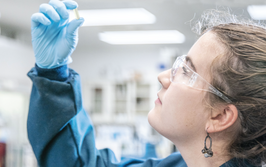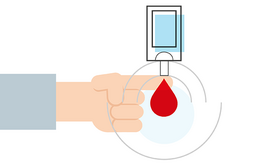Collaborating to Get Biopharma in the Fast Lane
Scaling up a bioprocess doesn’t need to be a headache – especially when there are firms out there that can lend a helping hand.
sponsored by GE Healthcare
Having been in the industry for more than 25 years, Patrick Guertin knows that cells can be temperamental and don’t like to be rushed, but in today’s biopharma industry speed to market is key. Guertin is a Global Technical Manager for GE Healthcare Life Sciences, where he focuses on upstream development and supporting the company’s Fast Trak services for process development and manufacturing.
GE Healthcare is working with a number of biopharma companies to help them advance their bioprocesses, including Roivant Sciences. Roivant specializes in picking up abandoned drugs from other companies that still have great potential, and has recently collaborated with GE on an investigational orphan drug product – RVT-801. We speak with Guertin and Alex Tracy, Vice President of Pharmaceutical Development at Roivant, to learn more about the challenges of speed to market and the details of their collaboration.

Left: Patrick Guertin. Right: Alex Tracy
What are the biggest challenges facing biopharma manufacturers today?
Patrick Guertin: Many companies are looking to optimize their bioprocesses and to move quickly from the development stage to clinic and, ultimately, to market – after all, time is money. The biopharma industry has matured a great deal over the past two decades and a plethora of new tools and technologies to aid the manufacturing process have been introduced, and yet scale-up can be a significant challenge. Cells can be unpredictable and can behave differently at large scale compared to lab scale.
Increasingly, biopharma companies are turning to service providers to help with the challenge. With GE’s Fast Trak services, our job is to support the development of a robust process including upstream and downstream process development, analytical development, quality assurance, quality control, and cGMP manufacturing. My focus is primarily on upstream process development, which encompasses everything from clone identification, to media optimization, process design and scale-up. For clients, it often comes down to understanding what scale they need to be at for manufacturing. Often, we’ll take a process that was developed in stainless steel and translate it into a single-use platform. I believe that flexibility is an advantage in biopharma production and that single-use systems can be a huge help in this regard since they facilitate scale-up, as well as help to reduce capital and operating expenditures. As an example, our bioreactors do not require steam-in-place (SIP) sterilization or clean-in-place (CIP). Also, they are scalable and can be used for a variety of process platforms, including mammalian, insect and microbial.
Alex Tracy: The industry is seeing ever increasing titers coming out of cell cultures. On the one hand, it’s great because it really reduces the overall manufacturing footprint, but it has clearly put some stresses on downstream unit operations. In time, the industry will have to learn to overcome this bottleneck, perhaps through better ligands and chromatography resins. Right now, it’s perhaps a good problem to have as the shrinking of manufacturing processes has enabled greater uptake of single-use technologies. Single-use systems make it more economical to manufacture drugs that require smaller quantities, such as drugs for orphan diseases. With RVT-801, for example, we are working at a relatively small volumetric scale.
How did Roivant and GE come to collaborate?
PG: Roivant’s investigational enzyme therapy, RVT-801, is being developed for the treatment of acid ceramidase deficiency, an ultra-rare, lysosomal storage disease that manifests as Farber disease. Roivant had a pre-existing clone that was only running in hollow fiber bioreactors, which is challenging to scale up. Working with Roivant, we took a series of clones from them, selected the best producer and best grower, optimized the media/feeds, and then scaled the process up using our single-use bioreactor platforms. We manufactured the bulk drug substance in our cGMP manufacturing suite and now we are transferring to a third party for Phase III and commercial manufacturing. It has been a very efficient and rewarding collaboration – particularly since there is no treatment for Farber disease. The whole collaboration has been defined by mutual respect and appreciation, and we have had some very good discussions with Roivant about what they thought they were getting in terms of product per volume per time in their original manufacturing platform, versus what we thought we could achieve with our bioreactor technology, which offered more flexibility in terms of scale-up.
AT: We actually inherited the partnership with GE Healthcare. Roivant obtains its assets through partnerships or acquisitions. Often we acquire compounds from large pharma companies who have already conducted Phase II trials, but aren’t planning to progress the molecule any further. We identify the promising molecules that we believe have a chance to make it to market and then we launch subsidiary companies to develop those molecules. RT-801 is being handled by our subsidiary, Enzyvant, for example.
When we acquired RVT-801, GE Healthcare had already been involved with the enzyme and its original developer, so it was perfectly natural to continue the work with them. For me, it’s been really interesting to continue my relationship with GE because I’ve been working with their systems since I was in graduate school. They are well known for their quality products and stability of supply. Since they have been involved with RVT-801 for a long time, the team at GE is also really engaged in the work and what it could mean for patients. RVT-801 has been granted orphan drug designation by regulatory agencies in the United States and the European Union.
Working in the rare disease space is incredibly rewarding. With Farber disease, patients are deficient in the enzyme that breaks down ceramide – ceramides then accumulate at the cellular level leading to the formation of subcutaneous nodules, inflammation, and joint contractures that present similar to juvenile idiopathic arthritis. Acid ceramidase deficiency can also cause spinal muscular atrophy with progressive myolonic epilepsy. Most patients are children and those that are severely affected do not have a long lifespan. It’s easy to become passionate about something when you see kids suffering. Enzyvant has been conducting a natural history study of patients with Farber disease to better define the natural course of disease and the relationship between specific symptoms, biomarkers, and prognosis. With respect to the product, we are focusing on a specific epitope – mannose 6 phosphate on the glycan structure that allows the protein to be internalized and correctly targeted. From our standpoint, having the protein with the correct glycosylation pattern is essential.
What are the main challenges associated with scaling up a bioprocess?
PG: I’ve seen a lot of companies with limited understanding of their process and insufficient relative data, which can lead to problems when moving from the lab to the commercial scale. You need to be asking, how are you controlling the critical process parameters? How does the process impact the molecule? And how can you align yourself with state-of-the-art technologies, and use them for the right processes?
AT: We were fortunate with RVT-801 in that we have a relatively well-behaved and stable enzyme – we haven’t had too many bioprocessing challenges to overcome, although we do need to be careful with the feed strategy for this particular cell line because of the high densities.
The amount of material required by the non-clinical group, however, has been another story. Farber disease is an ultra-rare disease that only impacts a handful of patients worldwide. Because the disease is so rare, we have a relatively small number of people recruited for clinical trials and we only need a very small amount for our first-in-human clinical studies. From a non-clinical perspective, the enzyme has been really well tolerated in toxicology studies and it has required a tremendous amount of material – which has been a surprise. I’ve had to dedicate a number of runs to produce the required amount of enzyme and I wasn’t quite prepared for it! In the long run it will be a positive, since it should give us a good therapeutic window to work with – and hopefully greater chances of clinical success for the future.
And what about technology transfer?
PG: It is vital to get technology transfer right to ensure smooth, rapid development. To ease the process, it’s worth normalizing the engineering metrics of the system in which you’re producing, such as the power input or mass transfer. Perhaps the most important element is communication and transparency. Working with a service provider is all about the relationship and you need a single point of contact. One of the benefits with our Fast Trak team is that we have a global footprint. For example, a client may come to us with a fragile process, which we transfer to our site in the US. The client may then wish to transfer the process to China. Because we have a team in China too, the two teams can collaborate and coordinate in terms of documentation and procedures.
AT: Technology transfer is usually pretty challenging, but it’s been pretty smooth so far. We’ve made three batches at GE at scale, put together a good initial package, and we think the product is suitable to take forward. There has been excellent dialogue between the two organizations and if there’s another opportunity to work with GE then we will. Since GE is known to have a huge breadth of experience in both upstream and downstream processing, you know you are going to get something that is ready for commercialization. The last thing you want is to invest in a partnership that still leaves you with substantial additional development at the end. Speed during development is, of course, important, but it’s useless to develop something with a burst of speed and then find you have to redo everything. In any kind of outsourcing, the hardest part is finding the right partner – as Patrick said, the relationship is critical. When you have a good partner and both of you are pulling together to get the product on the market it’s incredibly valuable – and difficult to assign a monetary value to.
The Biosimilars Viewpoint
By Patrick Guertin
In recent years, we’ve seen an increase in the number of biosimilar customers – indeed, biosimilars are a key trend in the industry overall thanks to pushes from patients, regulators and manufacturers. The opening of the US market also has provided a much needed boost for the biosimilars field. A lot of new players are entering the field, but not all of them have the right skills to cope with complex bioprocesses, fuelling a need for external services and advice.
One of the big debates around biosimilars is how close the molecule has to be to the original (innovator) drug. You are never going to produce an exact copy of a biopharma molecule (and even the original biopharma drug will experience some batch to batch variability due to the nature of cells), but you need to be within certain specifications. This requires a thorough understanding of the original product and how different bioprocesses might impact efficacy or other features of the molecule. The quality of the molecule and the time it takes to produce with a given plant capacity are critical variables. You need to understand your process and what quantity you require for your target market. You need to get the desired cell line with the right characteristics, and you need to maintain biosimilarity of the molecule through scale-up. It’s also always beneficial to obtain regulatory input – especially from those overseeing your target market. Local regulators can work in different ways – both subtle and dramatic.
With biosimilars, the biggest piece of advice I can offer overall is to align yourself with someone who has experience and expertise with the inherent characteristics and sensitivities involved in bioprocessing. There is plenty of support out there that can help you get to market faster. In addition, you need a team that can analyze a molecule in detail and tell you whether it has the right quality attributes. You also need a team that can control and refine the process documentation so that it’s robust and acceptable to your chosen regulators.
For more information about GE Healthcare's services please click here


Making great scientific magazines isn’t just about delivering knowledge and high quality content; it’s also about packaging these in the right words to ensure that someone is truly inspired by a topic. My passion is ensuring that our authors’ expertise is presented as a seamless and enjoyable reading experience, whether in print, in digital or on social media. I’ve spent fourteen years writing and editing features for scientific and manufacturing publications, and in making this content engaging and accessible without sacrificing its scientific integrity. There is nothing better than a magazine with great content that feels great to read.


















